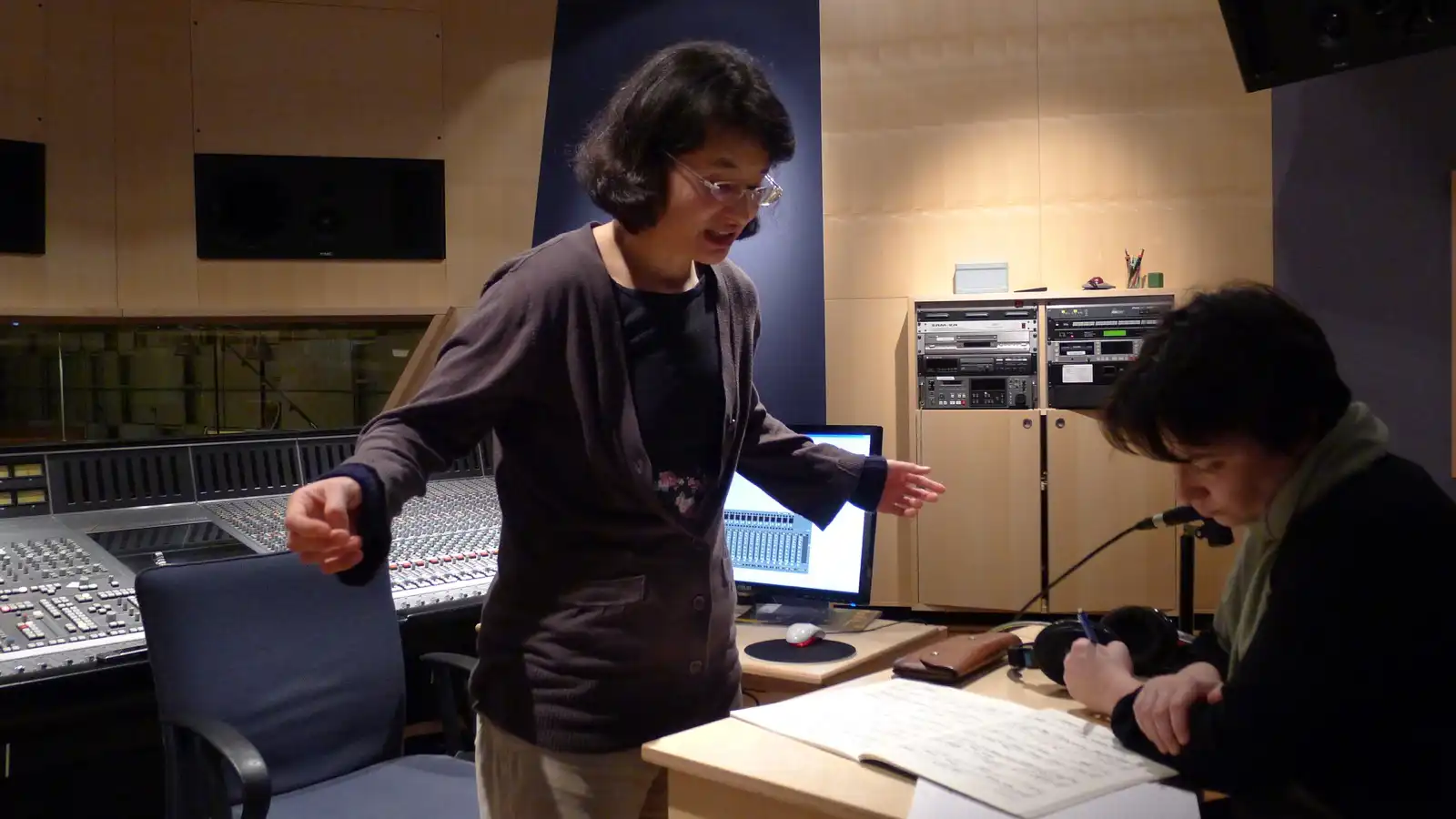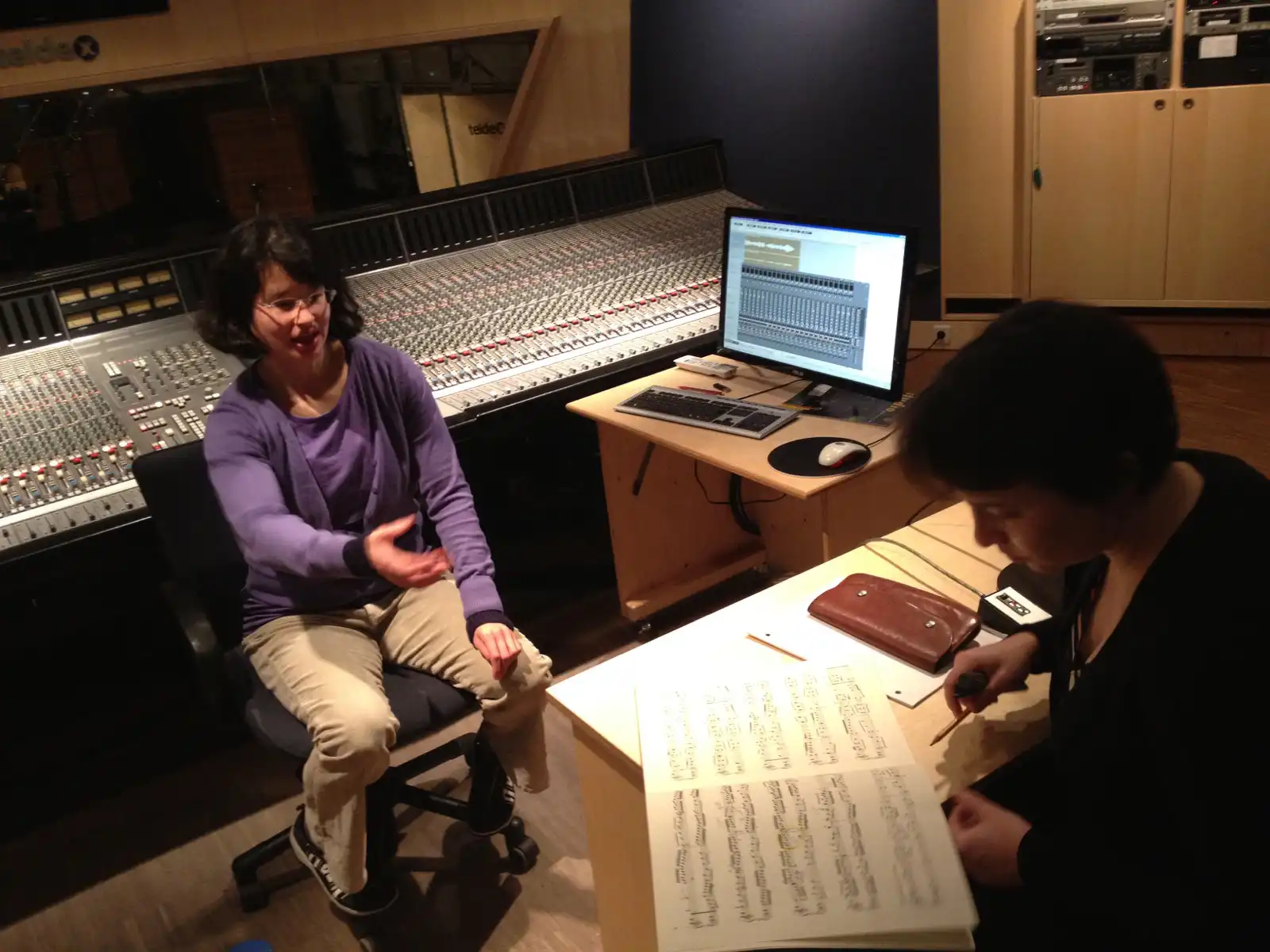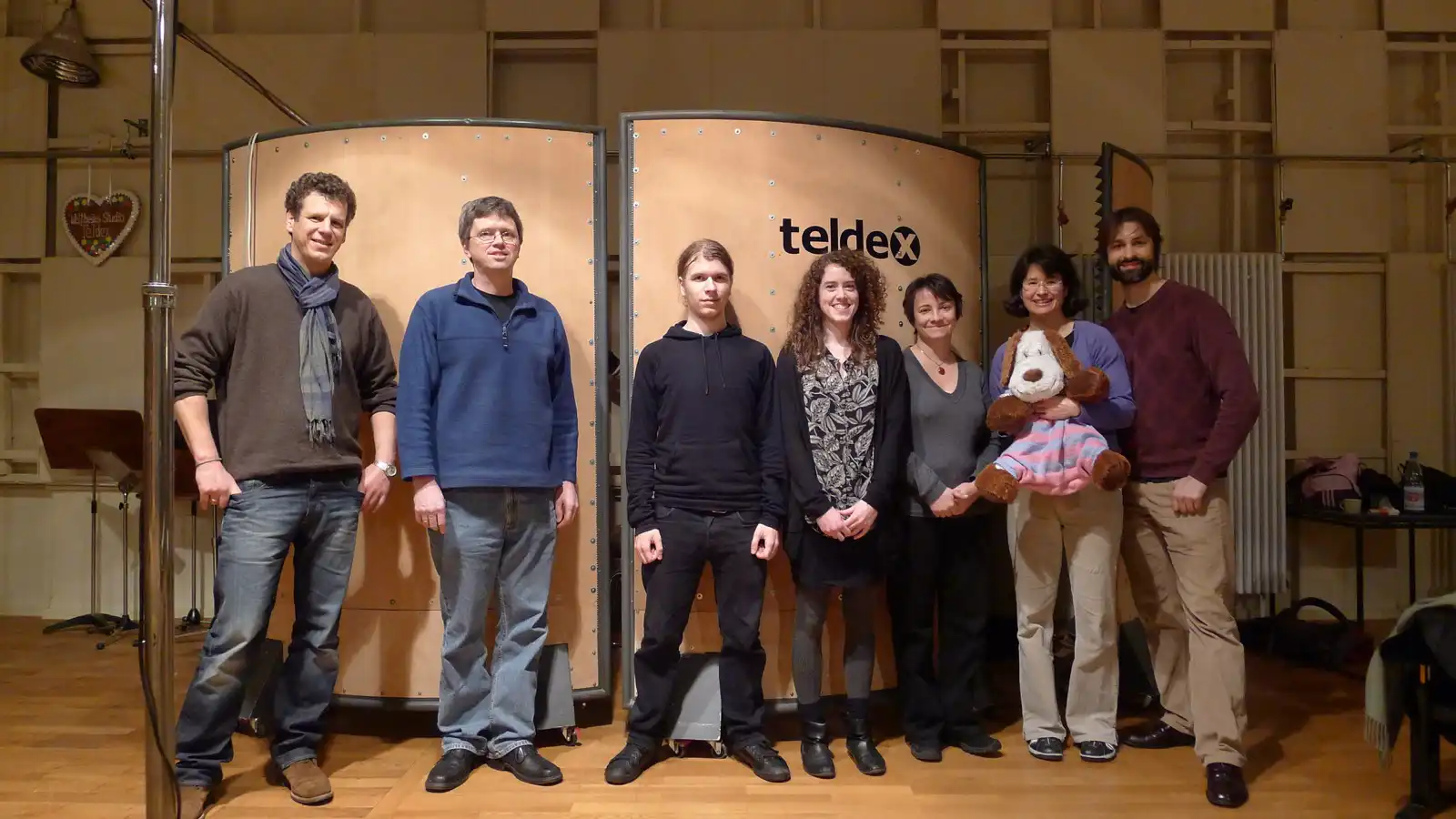Recording the Goldberg Variations at the Teldex Studio

Kimiko Ishizaka and Anne-Marie Sylvestre in the Teldex Studio
After a year of preparation and hard work, we've reached a significant milestone with the Open Goldberg Variations project: Kimiko Ishizaka has recorded the piece. The recording sessions went from January 9 to January 13, 2012, in the Teldex Studio in Berlin.
17 microphones and 6 pairs of ears
Kimiko was joined in the studio by Anne-Marie Sylvestre, the Producer of the recording, who flew in from Montreal just for these sessions, Tobias Lehmann, Recording Engineer and a partner at Teldex, Bernhard Farenholtz, master piano builder and technician who cared for the instrument, Robert Douglass, the Director of the Open Goldberg Variations project, and Cuddly, who played an important role in providing moral support, being cute, and in playing the CEUS takes. The sound and space inside of the Teldex Studio is amazing. Anne-Marie picked Teldex based on listening to dozens of piano recordings and picking only those that had achieved a perfect piano sound. To capture every nuance of the acoustic, and to be able to produce a high-definition surround sound recording, no fewer than 17 microphones were used. Earthquake: CEUS Saves the Day
One of the highlights of this recording is the Bösendorfer 290 Imperial CEUS piano that was sent from Vienna especially for Kimiko Ishizaka's Goldberg Variations recording. Not only does the piano fit Kimiko's playing style and sound concept, it is also equipped with Bösendorfer's CEUS technology. This allowed us to capture an additional set of information that will be used to make a modern “player piano” version Bach's work. Going into the
recording we had brainstormed about all of the possible uses of the CEUS technology in the studio. For example, we thought that it would be useful in playing back takes that Kimiko had just completed so that she could hear how it sounded, straight from the piano (instead of coming to the control room to hear it on speakers). We hypothesized that we could edit the CEUS to correct mistakes, then have the CEUS play back the corrected version to be recorded again. In the end we didn't do either of those things. The CEUS did help us at one point, though, and that was during the famous “Teldex Earthquake of 2012”. Normally the Teldex Studio is impervious to sounds from the outside. Planes, trucks, sirens, dogs, weather, honking horns and the like all get blocked out by the massive walls of the studio, preserving the perfect silence inside. Thus our surprise when, near the end of a particularly beautiful take, the entire building started shaking and a massive rumbling sound could be heard. Kimiko finished the variation she was playing, but it was clear that it had been acoustically destroyed. A nearby construction site had chosen that very moment to use their largest excavator to drive 4 meter metal pylons into the ground using a vibrating machine as a hammer. Fortunately, the construction team turned out to be very understanding, and when they learned we were recording they coordinated their schedule to do their earthquake inducing work during our lunch break. To rescue the lost take we let the CEUS system play the Bösendorfer, exactly as Kimiko had, and we recorded its sound in the quiet studio. This take may or may not make it to the final cut, but at least we have the option of using it, thanks to CEUS. Soundcloud comes to visit
Another highlight came on Thursday when we got visited by two members of the Soundcloud team, Robb Böhnke and Marie Elliott, who sat in on a couple hours of the recording and then joined us for dinner. Soundcloud provides a great widget for sharing music on the web. We're going to use Soundcloud to share the final Goldberg Variations with everybody when it gets released. The MuseScore developers and Soundcloud developers also run into each other frequently at various Music Hack Days around the world, thus it was totally natural to have them come over and participate in the project for a bit. Their timing was particularly good, too, as they were there to witness the “Thursday Night Miracle”.

Discussing the score
The Thursday Night Miracle
We had planned to go through all 32 pieces in order. On the first day, Monday, we started with the Aria and made it all the way to Variation 8. Every day we kept progressing, planning on finishing Friday afternoon, leaving some time at the end just in case there was anything that needed extra attention. Thursday was a big day. On the schedule were variations 23-27, five pieces that represent some of the hardest music in the entire piece. In particular there is number 25, a slow, soft, aching cry of pain and beauty that requires nerves of steel and a magic touch to make the piano sing in just the right way. Number 25 is also the longest variation, checking in at almost 10 minutes when played with repeats. Then there's number 26, perhaps the most athletic and exciting variation.
These five variations represented nearly 8 hours of total concentration and hard work for Kimiko by the time we were certain we had everything just the way it should be. After the last take of number 27 we were all exhausted. We had made dinner reservations at a nearby restaurant and we were all looking forward to the taste of some German beer. Computers were shut down and we were reaching for our jackets when Kimiko started playing the first Aria. Somehow she was feeling inspired, and not quite ready to quit for the day. Everyone stopped what they were doing, captivated by the music. Even though we had recorded this Aria on Monday already, it was clear that what Kimiko was playing in that moment was special. Someone in the control room said “We should be recording this”, and everyone agreed. Before we could say anything, Kimiko stopped and said “Do you think we should be recording this?” So the computers got turned back on, we sat down, started the tapes, and we ended the day with a beautiful version of the Aria that surpassed everything that we had recorded on Monday.
Cute Puppy Plays Bach
The normal recording ended right on schedule, Friday afternoon. Everybody was physically and emotionally drained, but we had a little bit of time left. We were all curious about the capabilities of the CEUS system, and wanted to be able to compare it directly to live playing. How better to make this comparison than to record it in the Teldex Studio? We'll release a series of side-by-side comparisons of unedited takes played by Kimiko, and then played by the CEUS alone. This will make it easy to directly compare the playing of the CEUS to a live performance. Cuddly volunteered to be the pianist for the CEUS takes, and the video of him playing turned out so cute that we decided to release it on its own as well.
Thanks to the team
In all, the sessions went better than anyone had expected. The team worked extremely well together and we were able to dive deep into the small nuances of Kimiko's interpretation to capture every detail. Kimiko kept her concentration up all week long and thrilled us with her playing. Anne-Marie Sylvestre and Tobias Lehmann are extremely experienced recording engineers and showed what excellent ears they have for the piano. Bernhard Farenholtz kept the Bösendorfer in prime condition and helped us achieve the ideal sound that Kimiko was looking for. Cuddly was damn cute the whole time. A perfect team! There is a lot of work to be done to finish the production of the final recording, but we'll share lots of updates along the way.

The full Open Goldberg Variations team in the studio